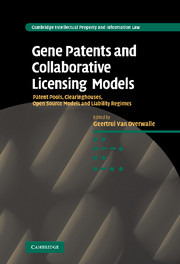 Gene Patents and Collaborative Licensing Models
Gene Patents and Collaborative Licensing Models Book contents
- Frontmatter
- Contents
- List of contributors
- Preface
- Foreword: Jean-Jacques Cassiman
- List of abbreviations
- Part I Patent pools
- Part II Clearinghouses
- Part III Open source models
- 12 Open source genetics. Conceptual framework
- 13 Case 8. CAMBIA's Biological Open Source Initiative (BiOS)
- 14 Case 9. Diversity Arrays Technology Pty Ltd. (DArT) Applying the open source philosophy in agriculture
- 15 Critical commentary on ‘open source’ in the life sciences
- 16 Several kinds of ‘should’. The ethics of open source in life sciences innovation
- Part IV Liability regimes
- Part V Different perspectives
- Part VI Summary and concluding analysis
- Index
- Titles in the series
14 - Case 9. Diversity Arrays Technology Pty Ltd. (DArT) Applying the open source philosophy in agriculture
from Part III - Open source models
Published online by Cambridge University Press: 14 January 2010
- Frontmatter
- Contents
- List of contributors
- Preface
- Foreword: Jean-Jacques Cassiman
- List of abbreviations
- Part I Patent pools
- Part II Clearinghouses
- Part III Open source models
- 12 Open source genetics. Conceptual framework
- 13 Case 8. CAMBIA's Biological Open Source Initiative (BiOS)
- 14 Case 9. Diversity Arrays Technology Pty Ltd. (DArT) Applying the open source philosophy in agriculture
- 15 Critical commentary on ‘open source’ in the life sciences
- 16 Several kinds of ‘should’. The ethics of open source in life sciences innovation
- Part IV Liability regimes
- Part V Different perspectives
- Part VI Summary and concluding analysis
- Index
- Titles in the series
Summary
Background
Diversity Arrays Technology Proprietary Limited (Pty Ltd) was founded in 2001 in Canberra, Australia, with support from the Biotechnology Innovation Fund of the Federal Government's ‘Backing Australia's Ability’ program. The company was set up as a wholly owned subsidiary of CAMBIA, a non- profit research institute based in Canberra, as one of the mechanisms to deliver this author's invention, Diversity Arrays Technology (DArT). After nearly two years of operating with this status, the company became privately owned in July 2003 with the mission of improving the efficiency of using natural resources through modern genetic and information technologies. At the time of writing, the company continues to focus on development and delivery of DArT under an ‘open source’-style licence. More recently the company has been moving towards more general genetic analysis services with increasing investment in informatics tools. At the same time, pressured by a significant increase in demand for its technology and services, the company is investing more resources in the international expansion of operations through creation of a network of similar organisations in several countries. This case study for ‘open source’ licensing constitutes a practical demonstration of the viability of service-based, non-proprietary business models in the field of biotechnology.
History
The roots of the company are strongly aligned with the initial stages of development of its main technology platform – DArT. In my role as Director of Genomics in CAMBIA I was charged with the task of developing technologies relevant to less developed countries' agriculture.
- Type
- Chapter
- Information
- Gene Patents and Collaborative Licensing ModelsPatent Pools, Clearinghouses, Open Source Models and Liability Regimes, pp. 204 - 212Publisher: Cambridge University PressPrint publication year: 2009


